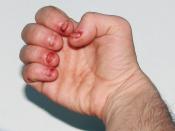Can you imagine never feeling at rest? It seems like no matter what you do, you canÃÂt stop thinking about the germs on your hands or the dust on the coffee table. You know in your mind that thinking about things such as this is ridiculous but you canÃÂt help but to wash your hands or dust the table. Temporarily the thoughts go away but then theyÃÂre back. You dust and wash again and again and again. Are you going crazy?Obsessive Compulsive Disorder is the culprit of these feelings and according to The National Institute for Mental Health displayed on the Mental Health Channel web page, about 3% of people in the United States have OCD. Although it doesnÃÂt sound as severe as some mental problems can be, it is. Obsessive Compulsive Disorder can be described as a debilitating disorder with undesirable or disturbing thoughts that make the person perform rituals to make the thoughts go away.
Typical obsessions include: the fear of dirt and germs, the fear of having an illness, the need for symmetry, and the inability to discard useless items. Typical Compulsions include: cleaning, counting, ordering or arranging, and asking for assurances. If a person possesses any of these concepts to an extent of it controlling their lives they are said to have OCD.
Brain structure and activation are associated with OCD. Problems in the frontal lobes, basal ganglia, and angulum are common in people with OCD. The reason this is suspected is because the Basil ganglia is involved in the routine behaviors part of the brain. The frontal lobes are for organizing and planning. Another hypothesis is that people with OCD have low serotonin would relieve the problem of OCD.
Although increasing serotonin levels in the brain remains only as a hypothesis, there are a...


